House of Leaves: An Annotated Bibliography of Epigraphs
Preface: Hi, I'm using my annotated bibliography of epigraphs for the chapters of Mark Z. Danielewski's House of Leaves to learn how to use steemit and and format in html. This is where I'm at so far after 6 or so hours of editing and coding (but I'm getting better!)
About the bibliography and House of Leaves. Summarizing House of Leaves is difficult, but probably the simplest or easiest summation is that it's about a house that's bigger on the inside than it is on the outside. From there it gets infinitely more complicated, especially if you follow the narrative off book which, at least in my case, is unavoidable since so much of the book has to do with references.
If by chance you'd like to reference this bibliography while reading HOL, this google doc might be easier to navigate than what I've put together here since google doc has the outline feature: https://docs.google.com/document/d/1SBQWyp07_i4ogl9d0X1cD8oYzxXJeKjRQCRTk1cmSfM/edit#heading=h.bmuv74erflhn
Thanks.
—MrSimsim
House of Leaves: An Annotated Bibliography of Epigraphs
Epigraph of Book:
Muss es sein? (Must it be?)
Possibly a reference to both/either Milan Kundera’s The Unbearable Lightness of Being and Beethoven’s String Quartet No. 16 in F major, Op. 135, his last substantial work.
A:
Kundera, Milan. Trans. Michael Henry Heim. The Unbearable Lightness of Being.
Harper Perennial Modern Classics; Reprint edition. 5 July 2005.
I haven’t read the book yet but Wikipedia and other internet sources say it’s a novel published in 1984 (written in 1982) by a Czechoslovakian writer, Milan Kundera, whose plot concerns two women, two men, and a dog who live in Prague during the 1960s. The phrase “es muss sein” appears in the beginning pages after Tomas, one of the lead characters, debates whether to follow Tereza, the young wife of Tomas, back to Prague. When he comes to a decision he tells his boss “es muss sein,” meaning he is fated to follow after Tereza. He has no choice. Must it be? It might as well.
Some of the novel’s themes:
- a. The movement of time. Nietzsche's circular, eternal return model of time versus linear time (everything only happens once).
- b. Dog time cannot be plotted along a straight line," he explains; "it does not move on and on, from one thing to the next. It moves in a circle like the hands of a clock, which-they, too, unwilling to dash madly ahead-turn round and round the face, day in and day out following the same path. (2.27.1)
- c. Fate versus free-will.
- d. Nietzsche’s concept of the heaviness of being versus Kundera’s concept of the lightness of being.
Also, according to an analysis provided by Shmoop.com, Beethoven is referenced in The Unbearable Lightness of Being as being related to the concept of heaviness.
At the end of the novel, Kundera refers to the man's "frown" and "improbably mane," and probably has this painting in mind. Not the most happy-go-lucky guy. On top of that, Beethoven is one of the great loves of Tereza, who, as we discuss in "Character Analysis," is associated with heaviness or weight. Tomas only learns to love Beethoven's music because of Tereza. And at the end of the novel ‘He comes to the "conclusion that the love story of his life exemplified not 'Es muss sein!' (It must be so), but rather 'Es konnte auch anders sein' (It could just as well be otherwise) (1.17.5).
http://www.shmoop.com/unbearable-lightness-of-being/es-muss-sein-beethoven-fortuity-symbol.html
B:
Beethoven, Ludwig Van. String Quartet No. 16 in F major, Op. 135. Schuppanzigh
Quartet. March 1828.
In the last movement entitled “Der schwer gefaßte Entschluß" (“The resolution hard to take” or "The difficult decision”), three ominous notes are marked “Muss es sein.” Some commentators seem to believe the section of the song was an attempt of Beethoven’s at describing the feeling of encountering the great eternal, but this opinion of Beethoven’s intention has never been (of course) definitively proven.
http://thebeethovenproject.com/must-it-be-must-what-be/
I (3)
—Beatles
Beatles. “A Day in the Life.” Sgt Pepper’s Lonely Heart Club Band. EMI Studios. 1967.
“A Day in the Life” is a fragmented song composed of two songs—the first 17 verses and last 6 verses written and vocalized by John Lennon; the middle eight verses written and vocalized by Paul McCartney—spliced together with chaotic interludes and a frenetic outro or coda that rises until it climaxes and ends with a massive, resounding, sustained E-major chord that continues to ring or resonate for over 40 seconds. The chord was created by three pianos (played by John Lennon, Paul McCartney, Ringo Starr and Mal Evans), as well as a harmonium played by George Martin. It took nine takes to get the sound they were looking for.
Lyrics
"A Day In The Life"
I read the news today oh boy
About a lucky man who made the grade
And though the news was rather sad
Well I just had to laugh
I saw the photograph
He blew his mind out in a car
He didn't notice that the lights had changed
A crowd of people stood and stared
They'd seen his face before
Nobody was really sure
If he was from the House of Lords
I saw a film today oh boy
The English Army had just won the war
A crowd of people turned away
But I just had to look
Having read the book
I'd love to turn you on
Woke up, fell out of bed
Dragged a comb across my head
Found my way downstairs and drank a cup
And looking up I noticed I was late
Found my coat and grabbed my hat
Made the bus in seconds flat
Found my way upstairs and had a smoke
And somebody spoke and I went into a dream
I read the news today oh boy
Four thousand holes in Blackburn, Lancashire
And though the holes were rather small
They had to count them all
Now they know how many holes it takes to fill the Albert Hall
I'd love to turn you on
"A Day in the Life – An Indepth Analysis – Recording the Song". web.archive.org. Archived from the original on 22 February 2008. Retrieved 18 September 2010.
An Analysis by Anda Mitchell-Dalla Bona
http://www.aaronkrerowicz.com/beatles-blog/formal-structure-in-beatles-music-96-a-day-in-the-life
II (8)
erroneously directed, scarcely ever fail in
ultimately turning to the solid advantage
of mankind.
—Mary Shelley
Shelley, Mary. Frankenstein; or, The Modern Prometheus. Lackington, Hughes, Harding,
Mavor & Jones. 1818. Chapter 3.
Mary Shelley’s novel concerning a science student, Victor Frankenstein, who creates a creature out of a conglomeration of corpse parts. The creatures gains sentient-hood, (free-will), which leads to Frankenstein losing control of his creation. The creature, after seeing his female counterpart (a possible solution to his misery) destroyed by her and his creator (Victor Frankenstein), seeks revenge and kills Victor’s new wife, Elizabeth. Victor chases after the creature over and through endless, rugged, and ultimately unforgiving terrain. This seemingly endless chase eventually ends Victor’s life. The creature cries over his creator’s body, either out of grief or because he realizes he is now truly alone, then heads off into the arctic never to be seen again.
III (19)
A:
becomes a photographer any more than
the lion tamer becomes a lion tamer.
—Dorethea Lange
Lange, Dorothea and Daniel Dixon. “Photographing the Familiar.” Aperture Magazine
Anthology. 1952.
An essay concerning the moral issues involved with the profession of photography which discusses the relationship of the photographer and the machine, stating:
For better or for worse, the destiny of the photographer is bound up with the destinies of a machine. In this alliance is presented a very special problem. Ours is a time of the machine, and ours is a need to know that the machine can be put to creative human effort (Lange).
The essay:
http://www.aperture.org/blog/archive-photographing-familiar-dorothea-lange-daniel-dixon/
B:
וְכִי אוֹצִיא אֶת־בְּנֵי יִשְׂרָאֵל מִמִּצְרָיִם ׃
— Exodus 3. 11
(Translated from Hebrew in footnote 24: ‘But Moses said to God, “Who am I that I should go to Pharaoh and free the Israelites from Egypt.”’)
Exodus. The Holy Bible. King James Version. (3.11)
This is the section of the Old Testament where Moses encounters the burning bush.
“10 Therefore, come now, and I will send you to Pharaoh, so that you may bring My people, the sons of Israel, out of Egypt." 11 But Moses said to God, "Who am I, that I should go to Pharaoh, and that I should bring the sons of Israel out of Egypt?" 12 And He said, "Certainly I will be with you, and this shall be the sign to you that it is I who have sent you: when you have brought the people out of Egypt, you shall worship God at this mountain” (KJV, Exodus 3: 10-12).
These two quotes may relate to each other because of the great power (of creation) the bush (God, or the invention of god depending on your point of view) and the machine that is the camera provide along with the responsibility necessary in the use of both utilities.
IV (24)
believe one half of it myself.
—Diedrich Knickerbocker
Irving, Washington. “The Legend of Sleepy Hollow.” The Sketch Book of Geoffrey
Crayon, Gent.1820.
The quote comes from Knickerbocker’s (Washington’s fictional narrator who appears or narrates in other stories such as “Rip Van Winkle”) postscript of “The Legend of Sleepy Hollow.” This post-script questions the authenticity or actuality of the story of Sleepy Hollow within the story.
V (41)
relieve the loneliness of the the place
—R.K. Narayan
Narayan, R.K. The Guide. Viking Press. 1958.
The Guide is about a disinterested-with-place tour guide who falls in love with a client after seeing her dance then becomes her stage manager only to lose his love after attempting to control her, who then is imprisoned for two years for committing forgery (signing for Rosie, the dancer he’s in love with and promotes), then released from prison, then mistakenly identified as a Sadhu or Swami (a spirit guide) and begins to inhabit an abandoned temple where he lives off the offerings of the villagers, who believe him to be holy, rather than returning home to face disgrace, then, because of these offerings, is forced to be the Swami they believe him to be and fasts in order to make it rain to end the famine that the drought has caused, which causes him to lose his health and begin to die as the fast and drought continue until the end of the book when and where he may have or may have not died after sensing rain falling in the hills and he “sagged down.” The book is not linear and jumps back and forth between the Swami timeline and the tour guide timeline.
The book seems to relate to HOL because the main character is an empty space that only gains identity through the act of others perceiving him.
Full book:
https://archive.org/details/guidenovel00nara
Pg 199
He split a case into a minute bits and demanded as many days for microscopic investigation. He would keep the court fidgeting without being able to rise for lunch, because he could talk without completing sentences; he had a knack of telescoping sentence into sentence without pausing for breath
He arrived by the morning train and left by the evening one, and until that time he neither moved off the court floor nor let the case progress even an inch for the day—so that a judge had to wonder how the day itself was spent.
VI (74)
A:
—Ernest Becker
Becker, Ernest. The Denial of Death. New York: Simon & Schuster. 1973.
I haven’t read the entire book yet but, based on what I have read and through various internet sources, the book is about how society or civilization is a symbolic defense mechanism against the eventuality of death. Becker argues we can transcend the impending dilemma that is death through heroism, which, according to Becker, is the act of being a part of something greater than one’s self thus the self is able to transcend from the self into the whole, or from the temporal into the internal. The book was awarded the Pulitzer Prize in General Nonfiction in 1974, two months after his death.
https://en.wikipedia.org/wiki/The_Denial_of_Death#References
B:
—Christian Norberg-Schultz
Norberg-Schulz, Christian. “The Concept of Space,” Existence Space
Architecture. Praeger Publishers. London. 1971.
This chapter or essay is about how man’s “interest in space has existential roots,” which stems from “a need to grasp vital relations in his environment.” The essay discusses how we orient ourselves with various objects, and how this orientation provides a “dynamic equilibrium” between man and his environment or space.
Epigraph to “The Concept of Space”:
Jakob von Uexküll:
Uexküll, Jakob von. “A Stroll Through The Worlds of Animals and Men: A Picture Book
of Invisible Worlds.” Instinctive Behavior: The Development of Modern Concept.
Trans. & Ed. Claire H. Schiller. Intl Universities Pr Inc. June 1957.
Almost glossed over the epigraph of “The Concept of Space.” But, after reading the essay again, I took a closer look at its epigraph and realized it was a reference to Jakob von Uexküll, a biologist and conceptual theorists, and his wonderful long essay or short book concerning the Umwelt, meaning “environment” or “surroundings,” an argument against the theory held by behaviorists, mechanists, zoologists and physiologists that animals, as well as the animal that is the human, are merely a grouping of parts that make up a machine meant to sustain itself. Uexküll claims what constitutes a creature is not just the pieces—eyes, skin, hands, feets, heart, lung, spleen bowels, etc.—which make up the creature's physical body but also the surroundings the creature perceives and is the center of.
(Also, I first heard of this guy from a non-fiction book called The Tiger: A True Story of Vengeance and Survival by John Vaillant, which is a helluva read about a tiger that hunted men in Russia’s Far East. Vaillant discusses the concept and implications of the Umwelt extensively in the book.)
Some quotes:
According to behaviorists, man’s own sensations and will are mere appearance, to be considered, if at all, only as disturbing static. But we who still hold that our sense organs serve our perceptions, and our motor organs our actions, see in animals as well not only the mechanical structure, but also the operator, who is built into his organs, as we are into our bodies. We no longer regard the animals as mere machines, but as subjects whose essential activity consists of perceiving and acting. We thus unlock the gates that lead to other realms, for all that a subject perceive becomes his perceptual world and all that he does, his effector world. Perceptual and effector worlds together form a closed unit, the Umwelt. These different worlds, which are manifold as the animals themselves, present to all nature lovers new lands of such wealth and beauty that a walk through them is well worth while, even though they unfold not to the physical but only to the spiritual eyes. So, reader, join as we ramble through these worlds of wonder (Uexküll 6).
And:
The projection of sensory impressions is a self-evident fact. All our human sensations, which represent our specific receptor signs, unite into perceptual cues (Merkmal) which constitute the attributes of external objects and serve as the real basis of our actions,. The sensation “blue” becomes “blueness” of the sky; the sensation “green,” the “greenness” of the lawn. These are the cues by which we recognize the objects: blue, the sky; green, the lawn (Uexküll 9)
Figuratively speaking, every animal grasps its object with two arms of a forceps, receptor, and effector. With one it invests the object with a receptor cue or perceptual meaning, with the other, an effector cue or operational meaning. But since all of the traits of an object are structurally interconnected, the traits given operational meaning must affect those bearing perceptual meaning through the object, and so change the object itself. This is best expressed briefly as: The effector cue or meaning extinguishes the receptor cue or meaning...
…the most decisive factor for the course of any action is the number and arrangement of receptor cells which, with aid of their receptor signs, furnish the objects of the Umwelt. with receptor cues, and the number and arrangement of effector cells which, by means of their effector signs, supply the same objects with effector cues (Uexküll 10).
Umwelt theory: all animals, from the simplest to the most complex, are fitted into their unique worlds with equal completeness. A simple world corresponds to a simple animal, a well articulated world to a complex one (Uexküll 11).
Some visual graphs or schematics from the book:
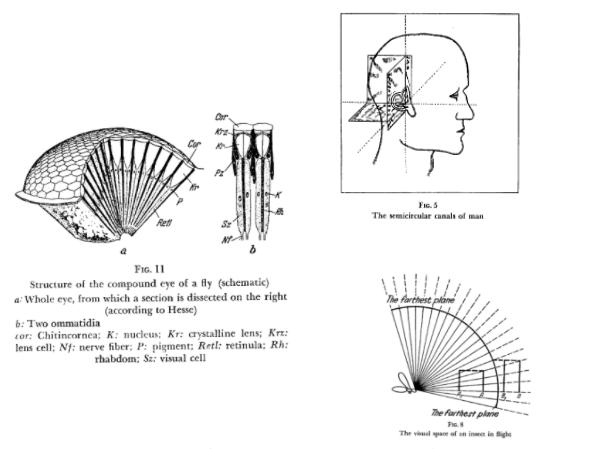
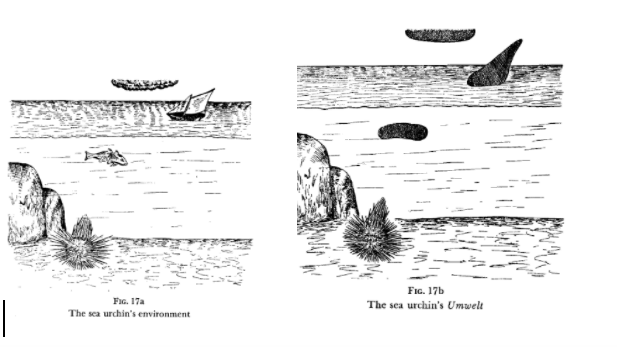
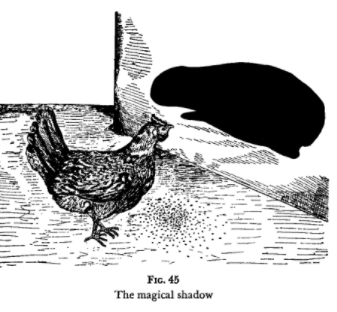
VII (80)
—Jack London
London, Jack. “To Build A Fire.” 1908.
A story about a guy simply named “Man” who chooses to travel through the wilderness to meet up with his friends “the boys” even though, as the husky who travels with him knows, the weather has made the land especially inhospitable to man. The story ends with the man dying. The last thing he sees is himself through the eyes of one of the “boys” when they find his corpse the next day. The story was first published in 1902 and then published again 1908. The plot of the 1902 version differs greatly from the plot of the 1908 version. In the first version it is not as cold, there is no dog, and the man survives, though he does suffer frostbite.
VIII (97)
—The Oxford English Dictionary
I haven’t found the book the definition mentions yet.
IX (107)
—Virgil
x Here is the toil of that house and the inextricable wandering” (Aeneid 6. 27).
“The house difficult of exit” (Ascensius (Paris 1501)); “difficult to enter” (Trevet (Basel 1490)).
(Basel? https://goo.gl/dpXnXo: Possibly a reference to the Council of Basel (1431-1437). Britannica: Council of Basel, a general council of the Roman Catholic church held in Basel, Switz. It was called by Pope Martin V a few weeks before his death in 1431 and then confirmed by Pope Eugenius IV. Meeting at a time when the prestige of the papacy had been weakened by the Great Schism (1378–1417), it was concerned with two major problems: the question of papal supremacy and the Hussite heresy. [The Hussites were followers of the Bohemian religious Reformer Jan Hus.]
—Jan Hus Wiki info: Hus was a key predecessor to the Protestant movement of the sixteenth century, and his teachings had a strong influence on the states of Europe, most immediately in the approval of a reformist Bohemian religious denomination, and, more than a century later, on Martin Luther himself.[2] He was burned at the stake for heresy against the doctrines of the Catholic Church, including those on ecclesiology, the Eucharist, and other theological topics.
After his execution in 1415, the followers of Hus's religious teachings (known as Hussites) rebelled against their Roman Catholic rulers and defeated five consecutive papal crusades between 1420 and 1431 in what became known as the Hussite Wars.[3] A century later, as many as 90% of inhabitants of the Czech lands were non-Catholic and some still followed the teachings of Hus and his successors.[4]
https://en.wikipedia.org/wiki/Jan_Hus
http://macrotypography.blogspot.com/2015_07_01_archive.html)
A:
Virgil. Trans. A.S. Kline. Aeneid. Book 6. Line 27.
http://www.poetryintranslation.com/PITBR/Latin/VirgilAeneidI.htm
A Latin epic poem written by Virgil somewhere between 29 and 19 BC. Aeneas is a Trojan who travels with his Trojan fleet to Italy in search of a new home for the Trojan people. In Book 6 Aeneas travels to the underworld where he speaks to the spirit of his father who tells him about the future of Aeneas’ offspring who in time will build Rome. In the first section of Book 6 (lines 1 through 55) Aeneas goes to the Temple at Cumae, a temple for Apollo (Phoebus) built by Daedalus next to multiple entrances to a maze of caves that lead into the underworld. Here he sees an urn depicting Pasiphae’s copulation with the bull and the birth of the Minotaur, a hybrid creature, the result of interspecies relations. The Cumaean Sibyl, his guide to the entrance of the underworld, tells him not to look upon the urn for:
This moment doesn’t require your sightseeing: it would
be better to sacrifice seven bullocks from a virgin herd,
and as many carefully chosen two-year old sheep (Trans. A. S. Kline).
B:
Jodocus Badius aka Badius Ascensius (1462–1535)
I’m unsure where the quote is cited from, but Jodocus Badius, also known as Badius Ascensius, was a French scholar, grammarian, pedagogue, and pioneer in the industry of the printing press.
Wiki info:
“Badius worked first as an editor and proof-reader for the printer Jean Trechsel in Lyon (1492–1498). He then moved to Paris where he set up his printing shop in 1503. His production was almost entirely in Latin. He specialised in editions of Roman classical texts, often with his own familiare commentum for the student market,[2] and also Latin works by contemporary humanist writers.[3]
Badius's shop was one of the most productive of the period 1501–1530: 775 editions are listed in the bibliography in Philippe Renouard's Imprimeurs & libraires parisiens du XVIe siècle. He frequently worked for or in partnership with Johannes Parvus (Jean Petit), who was by far the most important wholesale bookseller/publisher of this period.”
https://en.wikipedia.org/wiki/Jodocus_Badius
C:
Nicholas Trevet (c. 1257 – c. 1334)
Augustine, Saint Bishop of Hippo. Bonetus Locatellus; Octavianus Scotus; Thomas,
Waleys; Nicholas Trivet. De civitate dei. (City of God). Venice: Bonetus Locatellus for Octavianus Scotus. 18 Feb 1489/90.
Trevet was a Dominican friar in london. It looks like this quote was pulled from a commentary attached to an edition of De civitate dei, St Augustine’s City of God. De civitate dei was written in the early part of the 5th century and expounds on the principles of Christian theology such as divine omniscience, free will, suffering and righteousness, original sin, the evils of paganism and polytheism, and acts as a sort of apologia for the church’s role in the fall of the Roman Empire.
City of God link:
http://www.documentacatholicaomnia.eu/03d/1819-1893,_Schaff._Philip,_2_Vol_02_The_City_Of_God._Christian_Doctrine,_EN.pdf
Some background concerning Trevet:
http://www.brown.edu/Departments/Italian_Studies/heliotropia/10/papio.pdf
(Oliverolives/Teddy comment: “The piece from Brown University is all about interconnected literature and labyrinths of unfinished researched text.”)
look at this later, https://en.wikipedia.org/wiki/Martial#Works
http://ir.uiowa.edu/cgi/viewcontent.cgi?article=1273&context=mff
X (153)
—Dagobert Frey Grundlegung zu einer vergleichenden Kunstwissenschaft
Frey, Dagobert. Grundlegung zu einer vergleichenden Kunstwissenschaft. (Groundwork
for a Comparative Science of Art) Raum und Zeit in der Kunst der afrikanisch-eurasischen Hochkulturen. Vienna: Margarete Friedrich Rohrer Verlag. 1949.
Dagobert Frey was an Austrian art historian who stole art from the Warsaw and Kraków museums and national art galleries during the Nazi German occupation of Poland. I’m having trouble finding more information on him in English aside from what is provided by Wikipedia:
Career: Frey studied architecture in Vienna at the Technische Hochschule, and in 1911 obtained a job at the Austrian monument conservation bureau. In 1929 he published his controversial book about the Late Middle Ages and in 1931 moved to the Weimar Republic to teach art history in Breslau (Wrocław). After the invasion of Poland, he was selected by Berlin to validate Poland as a "Teutonic land" deliberately with no mention of Jews whatsoever. In 1941 he wrote his infamous book Krakau (German for Kraków) – denying this ancient Polish capital its Slavic origins. In 1942 he wrote a guide to the city of Lublin "without" Jews.[5] After the war, Frey moved back to Vienna and worked at the municipal office for the restoration of relics. In 1951 he moved to Stuttgart in southern Germany, where he obtained the position of professor at a local polytechnic. Frey never faced justice for his crimes committed in German occupied Poland.[4]
https://en.wikipedia.org/wiki/Dagobert_Frey
XI (246)
Roulant un manuscrit sous son pied convulsif,
Mesure d'un regard que la terreur enflamme
L'escalier de vertige où s'abîme son âme.—— Charles Baudelaire
(Footnote 220: “Something about the terror of the staircase.” Footnote 221: "The poet, sick, and with his chest half bare/ Tramples a manuscript in his dark stall./ Gazing with terror at the yawning stair/ Down which his spirit finally must fall." As Translated by Roy Campbell.—Ed.)
Baudelaire, Charles Pierre. “Sur Le Tasse en prison d'Eugène Delacroix.” Les Épaves.
1866.
Literal Google translation:
'The poet in the dungeon, bedraggled, sickly,
Rolling a manuscript under his convulsive foot,
Measure of a look that terror enflames
The dizzying staircase where his soul is an abyss.’
Note: Roy Campbell is known to have taken liberties in translation. Often including that which was implied rather than said.
Information derived from Wikipedia:
Charles Pierre Baudelaire was a French poet as well as essayist, art critic, and pioneering translator of Edgar Allan Poe.
His most famous work, Les Fleurs du mal (The Flowers of Evil), expresses the changing nature of beauty in modern, industrializing Paris during the 19th century. Baudelaire's highly original style of prose-poetry influenced a whole generation of poets including Paul Verlaine, Arthur Rimbaud and Stéphane Mallarmé among many others. He is credited with coining the term "modernity" (modernité) to designate the fleeting, ephemeral experience of life in an urban metropolis, and the responsibility art has to capture that experience.[2]
XII (275)
— William R. Halliday, M.D. American Caves and Caving
Halliday, William R MD. American Caves and Caving: Techniques, Pleasures and
Safeguards of Modern Cave Exploration Natl Speleological Society; Revised edition. Hardcover. 1974.
This book is full of descriptions concerning caverns as well as the techniques and equipment used to explore them.
Editor’s Note:
"Every sport eventually develops its definitive standard. A comprehensive study of American caves, spelunking techniques and equipment by the director of the Western Speleological Survey, this book should become the manual of American caving.
The book describes the types of caves available to spelunkers in North America. Lava tubes, glacier caves, and other lesser-known structures, as well as the popular limestone caves, are analyzed to expose their respective delights. Finding caves can be difficult, and the reader is given geological clues for locating each type of cave.
Equipment is meticulously discussed. The assorted types of brake bar rigs for rappelling, mechanical ascending devices, and ropes are examined. An entire chapter is devoted to the types of headlamps available and divulges their weaknesses and strengths.
Proper protection from wind, water and abrasion is necessary. Dr. Halliday computes chill factors and encourages adequate preparation by informative suggestions. The debate regarding synthetics, wool and cotton is renewed in respect to the particular demand of caving.
Techniques of vertical caving ascending, descending, belaying, and exploratory procedures are covered. Optional techniques and frank reasons for the author's preferences of when and where to use what are related. The author has many anecdotes that illustrate his points and illuminate his irrepressible humor.
Two chapters are of special interest, Cave Medicine and First Aid and Cave Search and Rescue. The author's experience as a physician is immediately apparent. His first-hand experience in rescue provides important dos and don'ts when faced with an emergency."
XIII (313)
Sombra, pero ya el hecho de nombrarlo
Y de conjecturar su circunstancia
Lo hace ficción del arte y no criatura
Viviente de las que andan por la tierra.
— Jorge Luis Borges
(Footnote 255: ”. . . a slow shadow spreads across the prairie,/ but still, the act of naming it, of guessing/ what is its nature and its circumstances/ creates a fiction, not a living creature,/not one of those who wander on the earth." As translated by Alastair Reid.')
Luis Borges, Jorge. The Other Tiger. Morris: Sigurd The Volsung. 1876.
Complete translation here: http://genius.com/Jorge-luis-borges-the-other-tiger-annotated
XIV (347)
—Enkidu
Anonymous. Trans. N. K. Sandars. The Epic of Gilgamesh: An English Verison with an
Introduction. Penguin Books. 1960.
The Epic of Gilgamesh is the story of Gilgamesh, the demigod king of Sumerian Uruk. Gilgamesh’s main motivation in the story is to overcome mortality through a series of quests and battles. Enkidu is Gilgamesh’s counterpart or antithesis (he is also, since both are godly creations, Gilgamesh’s half-brother), who was created out of a combination of clay and saliva provided by goddess Aruru to challenge the arrogance of Gilgamesh. He was sort of man-beast in that he lived in the wilderness, ate grass, and drank at the same watering holes as the animals. He is tamed by a temple prostitute.
Depending on the version or tablet, Enkidu either becomes ill and dreams about the underworld for 12 days until succumbing to his illness, or travels to the underworld on behalf of Gilgamesh to retrieve a catalogue of items he somehow let fall down into the underworld such as a drum, a harp, and certain gifts from Ishtar, the goddess of fertility, love, war and sex, the goddess who Gilgamesh refuses earlier in the narration. Gilgamesh gives Enkidu a series of rules to follow on his journey to avoid being entrapped by the underworld—such as no weapons, no kissing the girls or holding hands with children, no striking of any boy, no purple clothes or makeup, in fact just go “naked, filthy, and tearful”—and then Enkidu sets off into the underworld and violates all of the previously mentioned stipulations, and, because of his infractions, death “just swallowed him, unrecognized.”
http://www.piney.com/Gil12.html
Full Text:
https://goo.gl/Qjq2np
XV (353)
—Heine
(Footnote 322: "With his nightcaps and the tatters of his dressing-gown he patches up the gaps in the structure of the universe"—which he quoted in full to his wife, as well as alluded to in chapter Six of The Interpretation of Dreams and in a letter to Jung dated February 25, 1908.
Footnote 323: Heine?
Footnote: Freud. —Ed.”)
Heine, Heinrich. Trans. Charles G. Leland. Heine's Book of Songs. Ann Arbor, Michigan:
University of Michigan Library. 2005.
An excerpt from Heinrich Heine’s poem “Zu fragmentarisch ist Welt und Leben” (“Too Fragmentary is the World and Life”) found in the “Die Heimkehr” (“The Homecoming”) section of his 1827 anthology, “Buch Der Lieder” (“Book of Songs”).
Full poem:
Zu fragmentarisch ist Welt und Leben!
Ich will mich zum deutschen Professor begeben.
Der weiß das Leben zusammenzusetzen,
Und er macht ein verständlich System daraus;
mit seinen Nachtmützen und Schlafrockfetzen
Stopft er die Lücken des Weltenbaus.
Google Translate:
Too fragmentary is the world and life!
I want to put myself to the German professor.
The white piece together the life,
And he makes a comprehensible system thereof;
with his nightcaps and dressing gown scraps
He plugs the gaps in the world construction
Leland’s translation (147)
This world and this life are so scattered, They try me;
And so to a German professor I’ll hie me.
He can well put all the fragments together
Into a system, convenient and terse;
While with his night-cap and dressing robes tatters
He’ll stop up the chinks of the wide universe.
Heine was a German poet in the 19th century. He had radical political views (an acquaintance and distant relative of Karl Marx, though it seems their political views were incompatible) and used satire to attack the Prussian ruling class. For the last eight years of his life he was bound to his “mattress prison.” Later, by testing a hair sample, it was determined he suffered from lead poisoning.
https://archive.org/stream/heinesbookofsong00heiniala#page/146/mode/2up
l
https://translate.google.com/translate?hl=en&sl=de&u=http://www.staff.uni-mainz.de/pommeren/Gedichte/BdL/&prev=search
http://www.staff.uni-mainz.de/pommeren/Gedichte/BdL/Heimk-58.html
XVI (370)
— Albert Einstein
Einstein, Albert. “Geometry and Experience.” Prussian Academy of Sciences. Berlin. 27
January 1921. Lecture.
Basically the speech is about how mathematics is not a utility that can aptly describe reality because there is no way that numbers can adequately describe, mimic, or interpret perception.
http://www.zionism-israel.com/Albert_Einstein/albert_einstein_Geometry_Experience.htm
XVII (384)
aus deiner Stube, drin du alles weißt;
als letztes vor der Ferne liegt dein :
Wer du auch seist.
—Rilke
(‘"Whoever you are, go out into the evening,/ leaving your room, of which you know each bit;/ your house is the last before the infinite,/ whoever you are." As translated by C. F. MacIntyre.')
Rilke, Rainer Maria. Trans. C.F. MacIntyre. Selected Poetry of Rilke. University of
California Press; Bilingual edition. 1 August 1961.
Rilke, Rainer Maria. Trans. M. D. Herter Norton. “Prelude.” Translations from the Poetry
of Rainer Maria Rilke. W.W. Norton & Company Inc. New York, NY. 1938
From Rainer Rilke’s poem “Eingang” (“Entrance” or “Entry” or “Prelude), first published at the beginning of his 1902 collection Buch der Bilder (“Book of Pictures”).
Full Poem and Translation:
Eingang
Wer du auch seist: am Abend tritt hinaus
aus deiner Stube, drin du alles weißt;
als letztes vor der Ferne liegt dein Haus:
wer du auch seist.
Mit deinen Augen, welche müde kaum
von der verbrauchten Schwelle sich befrein,
hebst du ganz langsam einen schwarzen Baum
und stellst ihn vor den Himmel: schlank, allein.
Und hast die Welt gemacht. Und sie ist groß
und wie ein Wort, das noch im Schweigen reift.
Und wie dein Wille ihren Sinn begreift,
lassen sie deine Augen zärtlich los…
Google Translate:
Whoever you are: the evening walks out
from your office, there you know everything;
as a last resort before the distance is your house:
Whoever you are.
With your eyes, which hardly tired
from the spent threshold is exempt,
you slowly lift a black tree
and present it to the sky: slender, alone.
And have made the world. And it is big
and how a word that still matures in silence.
And as thy will understand its meaning,
Let your eyes tenderly happen ...
M. D. Herter Norton translation
Prelude
Whoever you are: at evening step forth
Out of your room, where all is known to you;
Last thing before the distance lies your house:
whoever you are.
With your eyes, which wearily
scarce from the much-worn threshold free themselves,
you lift quite slowly a black tree
and place it against the sky: slender, alone.
And you have made the world. And it is large
and like a word that yet silence ripens.
And as your will takes in the sense of it,
tenderly your eyes let go...
Full Book:
https://goo.gl/AMhR1p
Full Poem:
http://rainer-maria-rilke.de/06a001eingang.html
XVIII (408)
— A briefe and true report of the new found land of Virginia by Thomas Hariot servant to Sir Walter Raleigh — "a member of the Colony, and there imployed in difcouering.
Hariot, Thomas and Royster, Paul, editor. “A Briefe and True Report of the New Found
Land of Virginia 1588.” (1588). Electronic Texts in American Studies. Paper 20.
Thomas Hariot’s account of an expedition to the “New World” made between 1585 and 1586. The majority of the account is an extensive catalogue of North Carolina’s flora, fauna, geographical and geological features. The final third of the account has to do with an anthropological/ethnographical description of the native inhabitants as well as a description of how Hariot’s group related culturally, especially in regards to religion, god or gods, and creation myths. One specific belief of the native’s mentioned by Hariot was the belief that the soul was immortal and that after the soul has left the body it either goes to a heaven or a hell. He also mentions two stories concerning two men who the natives claimed arose out of the grave with stories about the underworld.
Wiki Info:
Sir Walter Raleigh (/ˈrɔːli/, /ˈræli/, or /ˈrɑːli/;[2] circa 1554 – 29 October 1618) was an English landed gentleman, writer, poet, soldier, politician, courtier, spy, and explorer. He was cousin to Sir Richard Grenville and younger half-brother of Sir Humphrey Gilbert. He is also well known for popularising tobacco in England.
b.Thomas Harriot (Oxford, ca. 1560 – London, 2 July 1621) — or spelled Harriott, Hariot, or Heriot — was an English astronomer, mathematician, ethnographer, and translator. He is sometimes credited with the introduction of the potato to the British Isles.[1] Harriot was the first person to make a drawing of the Moon through a telescope, on 26 July 1609, over four months before Galileo.[2]
After graduating from St Mary Hall, Oxford, Harriot travelled to the Americas, accompanying the 1585 expedition to Roanoke island funded by Sir Walter Raleigh and led by Sir Ralph Lane. Harriot was a vital member of the venture, having translated and learned the Carolina Algonquian language from two Native Americans, Wanchese and Manteo. On his return to England he worked for the 9th Earl of Northumberland. At the Earl's house, he became a prolific mathematician and astronomer to whom the theory of refraction is attributed.
Summary:
http://docsouth.unc.edu/nc/hariot/summary.html
Full Text:
[http://digitalcommons.unl.edu/cgi/viewcontent.cgi?article=1020&context=etas](
XIX (418)
— Susan Sontag
On Photography
Sontag, Susan. On Photography. New York: Farrar, Straus and Giroux. 1977.
On Photography, published in 1977, is a meditation on photography, the photographer and the photographed. In the book Sontag argues that photography acts as an equalizer, leveling the amount of meaning attributed to all events and that the photographer is a “Chronic Voyeurist” who attempts to create a separate, immortal world from the actual, mortal world where death and suffering are a constant. It begins with the famous "In Plato's Cave" essay, then offers five other prose meditations on the topic of photography (America Seen Through Photographs, Darkly; Melancholy Objects; The Heroism of Vision; Photographic Evangels; and The Image-World) and concludes with a "Brief Anthology of Quotations: [Homage to W.B.]” which is basically an echo chamber of quotations from thinkers thinking similar thoughts.
(Excerpt)
http://www.susansontag.com/SusanSontag/books/onPhotographyExerpt.shtml
(Full Book)
http://art.buffalo.edu/coursenotes/art314/sontag.pdf
XX (423)
A:
— Poe
Poe. “Hello.” Hello. Atlantic. 1996.
This is a reference to Poe, the singer (Danielewski’s sister) rather than a reference to Edgar Allan Poe, the writer, but also, perhaps, both.
Full lyrics:
Hello, hello
Are you out there?
M.O.D. are you out there?
I can't see your face
But you left a trace on a data back-road
That I almost erased
Not even God takes this long to get back
So get back
'Cause I hit a fork in the road
I lost my way home
I'm cut off from out main line
Like a disconnected modem
Hello
Tap in the code
I'll reach you below
No one should brave the underworld alone
Hello, hello, hello
How do I reach you?
Word has it on the wire
That you don't who you are
Well if you could jack into my brain
You'd know exactly what you mean here
Mothers are trails on stars in the night
Fathers are black holes that suck up the light
That's the memory I filed on the fringe
Along with the memory of the pain you lived in
Hello
I don't have the password
But the path is chainlinked
So if you've got the time
Set up the tone to sync
Tap in the code
I'll reach you below
Hello, hello
Are you out there?
Trigger happy Jack
He scares easily
It makes him so angry
At me
And his head it spins around
Just like the Exorcist and I
Find it ever so
Hard to resist his cries
But there's nothing more sadistic than an infant
Waving his pistol in my face
He wants me right down on my knees
Crumbling in disgrace
But he underestimates my mind
I know he's messing with my head
My only weakness is
I can't believe the guy could be entirely dead
Chorus:
Can't talk to a psycho like a normal human being
Can't talk to a psycho like a normal human being
Trigger Happy Jack
You're gonna blow
But I'm gonna get off
before you go
My Trigger Happy Jack is just a
drive by a go-go
And after awhile he calms down
And he looks at me like a prince
But I know I better bite the bullet
'Cause it's just another one of his
Jedi mind tricks
But this ain't no headtrip honey
This is a collision on the road
And you've got me feeling oh just like a roadkill
and you know deep down I know
Chorus
Why do you make me feel like this? (1-2-3-4)
Why do you gotta be such a dick? (1-2-3-4)
Why do you make me feeling like this? (1-2-3-4)
Why do you gotta be such a dick? (1-2-3-4)
Go-go
And I hate myself
Just enough to want him
But I hate him just enough to get off
But I understand him
Maybe I'm just crazy enough
To love him
Why not? (Why not?)
You can't talk to a psycho like a normal human being...
B:
Braille text.
('"The walls are endlessly bare. Nothing hangs on them, nothing defines them. They are without texture. Even to the keenest eye or ‘most sentient fingertip, they remain unreadable. You will never find a mark there. No trace survives. The walls obliterate everything. They are permanently absolved of all record. Oblique, forever obscure and unwritten. Behold the perfect pantheon of absence."—— [Illegible]')
I’m not sure if this is a reference to anything specific or if it’s a reference made up by the author or authors.
Any thoughts?
XXI (491)
— Thomas F. Hornbein
Everest—The West Ridge
Hornbein, Thomas F. Everest, The West Ridge. Mountaineers Books. 15 April 2013.
The book is an account of an expedition in 1963 by Thomas Hornbein and Willi Unsoeld to ascend Everest by way of the West Ridge (a much more challenging route than previously ascended routes up the South Col and Southeast Ridge or the North Col and Northeast Ridge) and descend down through the Southeast Ridge/South Col route. The pair fell behind schedule, ran out of oxygen, and had to spend most of the night huddled together on the mountain with two other climbers before descending at 4:00 o’clock in the morning and eventually making it to camp with severe frostbite (Unsoeld lost a few toes).
The night was overwhelming empty. The black silhouette of the Lhotse Mountain was lurking there, half to see, half to assume, and below of us. In general there was nothing – simply nothing. We hung in a timeless gap, pained by an intensive cold air – and had the idea not to be able to do anything but to shiver and to wait for the sun arising (Hornbein).
http://www.outsideonline.com/1899251/fifty-years-later
XXII (522)
— Ino
Can’t seem to find a book this quote directly references yet (unless invented) but Ino is a character of Greek mythology. (There’s also the call and response quality to the quote and source).
Wiki Info:
In Greek mythology Ino (/ˈaɪnoʊ/ Greek: Ἰνώ Ancient: [iːnɔ̌ː][1]) was a mortal queen of Thebes, who after her death and transfiguration was worshiped as a goddess under her epithet Leucothea, the "white goddess." Alcman called her "Queen of the Sea" (θαλασσομέδουσα),[2] which, if not hyperbole, would make her a doublet of Amphitrite.
In her mortal self, Ino, the second wife of the Minyan king Athamas, the mother of Learches and Melicertes, daughter’ of Cadmus and Harmonia[3] and stepmother of Phrixus and Helle, was one of the three sisters of Semele, the mortal woman of the house of Cadmus who gave birth to Dionysus. The three sisters were Agave, Autonoë and Ino, who was a surrogate for the divine nurses of Dionysus: "Ino was a primordial Dionysian woman, nurse to the god and a divine maenad" (Kerenyi 1976:246).
https://en.wikipedia.org/wiki/Ino_%28Greek_mythology%29
Maenads were the female followers of Dionysus who were reputed to tear their own children limb from limb in their madness.
(Wiki God/Hero/Heroin Tree)
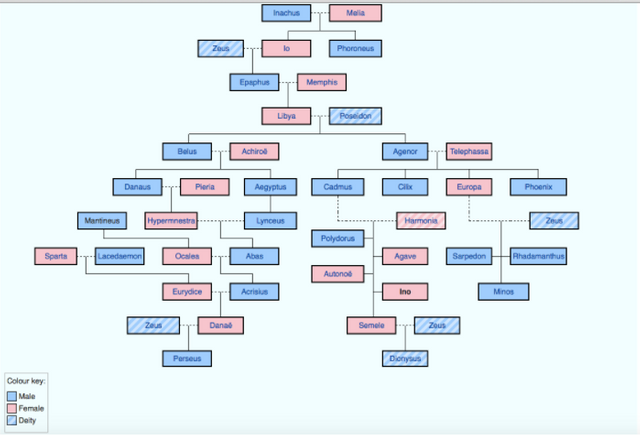
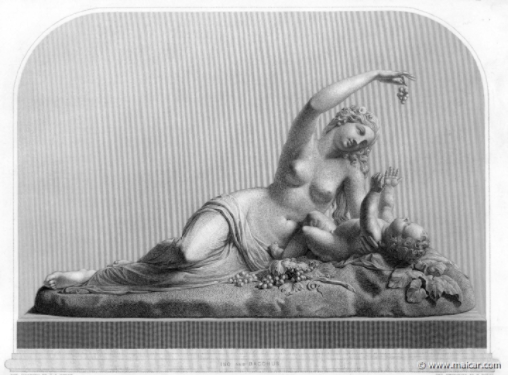
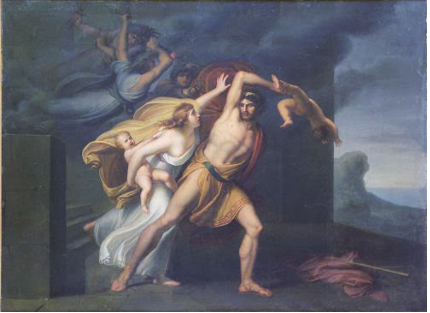
“To escape him Ino threw herself into the sea with her son Melicertes. The pair were welcomed into the company of the marine gods and renamed Leucothea (the White Goddess) and Palaimon. Leucothea was a sea goddess who aided sailors in distress”
http://01greekmythology.blogspot.com/2014/02/ino-leucothea.html
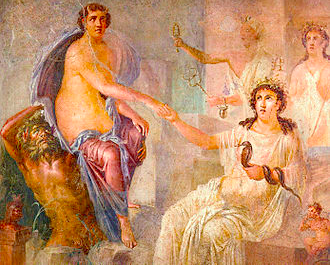
(The goddess Isis (seated right) welcoming the Greek heroine Io into Egypt, as depicted in a Roman wall painting from Pompeii)
XXIII (526)
— Diane Cook
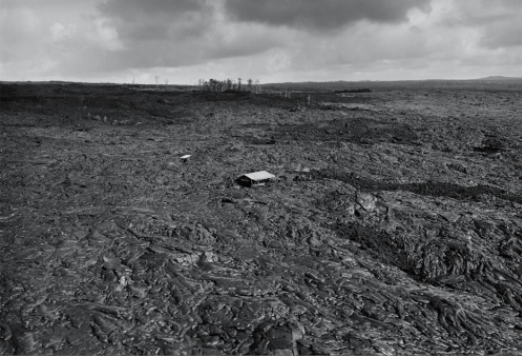
A reference to Diane Cook’s (who, along with her husband, Len Jenshel, has worked for National Geographic as well as many other publications) photograph of a house still standing surrounded by an ocean of hardened lava after the Kupaianaha vent of Kīlauea destroyed most of the town of Kalapana, Hawaii.